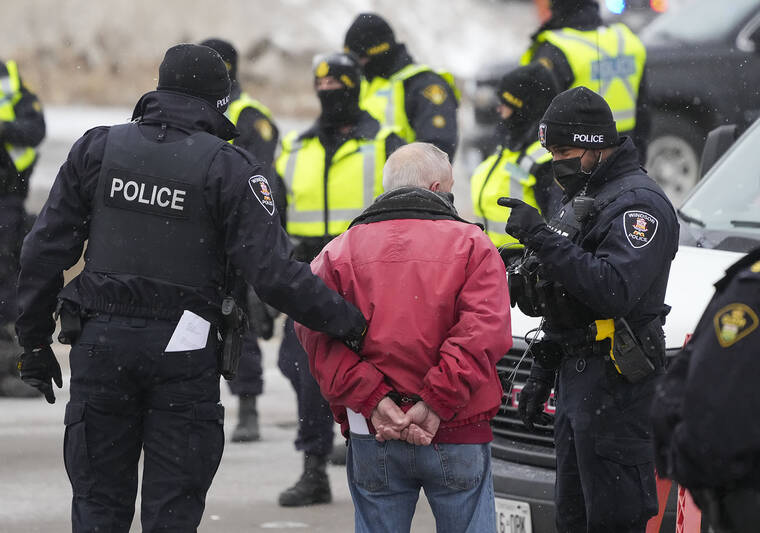Key US-Canada bridge reopens after police clear protesters
WINDSOR, Ontario — The busiest U.S.-Canada border crossing reopened late Sunday after protests against COVID-19 restrictions closed it for almost a week, while Canadian officials held back from a crackdown on a larger protest in the capital, Ottawa.
Detroit International Bridge Co. said in a statement that “the Ambassador Bridge is now fully open allowing the free flow of commerce between the Canada and US economies once again.” Esther Jentzen, spokeswoman for the company, said in a later text to The Associated Press that the bridge reopened to traffic at 11 p.m. EST.
ADVERTISING
The crossing normally carries 25% of all trade between the two countries, and the blockade on the Canadian side had disrupted business in both countries, with automakers forced to shut down several assembly plants.
Police in Windsor, Ontario, said earlier in the day that more than two dozen people had been peacefully arrested, seven vehicles towed and five seized as officers cleared the last demonstrators from near the bridge, which links the city — and numerous Canadian automotive plants — with Detroit.
The protest in Ottawa, meanwhile, has paralyzed downtown, infuriated residents who are fed up with police inaction and turned up pressure on Prime Minister Justin Trudeau, who presided at a Cabinet meeting late Sunday.
A senior government official said Trudeau planned to meet virtually with the leaders of Canada’s provinces Monday morning. The official spoke on condition of anonymity as they were not authorized to speak publicly.
The demonstrations have reverberated across Canada and beyond, with similar convoys in France, New Zealand and the Netherlands. The U.S. Department of Homeland Security warned that truck convoys may be in the works in the United States.
The Ambassador Bridge had remained closed for most of the day despite the break up of the protest as a heavy snowstorm blanketed the area. Windsor Mayor Drew Dilkens had said the span would open once authorities determined it was safe to do so.
Canada’s industry minister, François-Philippe Champagne, welcomed the development, saying on Twitter: “Good news. Glad to see that the Ambassador Bridge is now reopened.”
U.S. President Joe Biden’s administration on Sunday acknowledged the seemingly peaceful resolution to the demonstration, which it said had “widespread damaging impacts” on the “lives and livelihoods of people” on both sides of the border.
“We stand ready to support our Canadian partners wherever useful in order to ensure the restoration of the normal free flow of commerce can resume,” Homeland Security Advisor Dr. Liz Sherwood-Randall said in a statement.
In Ottawa, which is about 500 miles northeast of Windsor, Mayor Jim Watson said Sunday the city struck a deal with protesters who have jammed downtown streets for more than two weeks that will see them move out of residential areas in the next 24 hours.
Watson said he agreed to meet with demonstrators if they confined their protest to an area around Parliament Hill and moved their trucks and other vehicles out of residential neighborhoods by noon Monday.
The mayor shared a letter from one of the protest’s organizers, Tamara Lich, in which she said demonstrators “agree with your request” to focus activities at Parliament Hill. But Lich later denied there was an agreement, saying in a tweet: “No deal has been made. End the mandates, end the passports. That is why we are here.”
Watson added in his letter to protesters that residents are “exhausted” and “on edge” due to the demonstrations and warns that some businesses are teetering on the brink of permanent closure because of the disruptions.
The ranks of protesters had swelled to what police said were 4,000 demonstrators by Saturday, and a counter-protest of frustrated Ottawa residents attempting to block the convoy of trucks from entering the downtown emerged Sunday.





